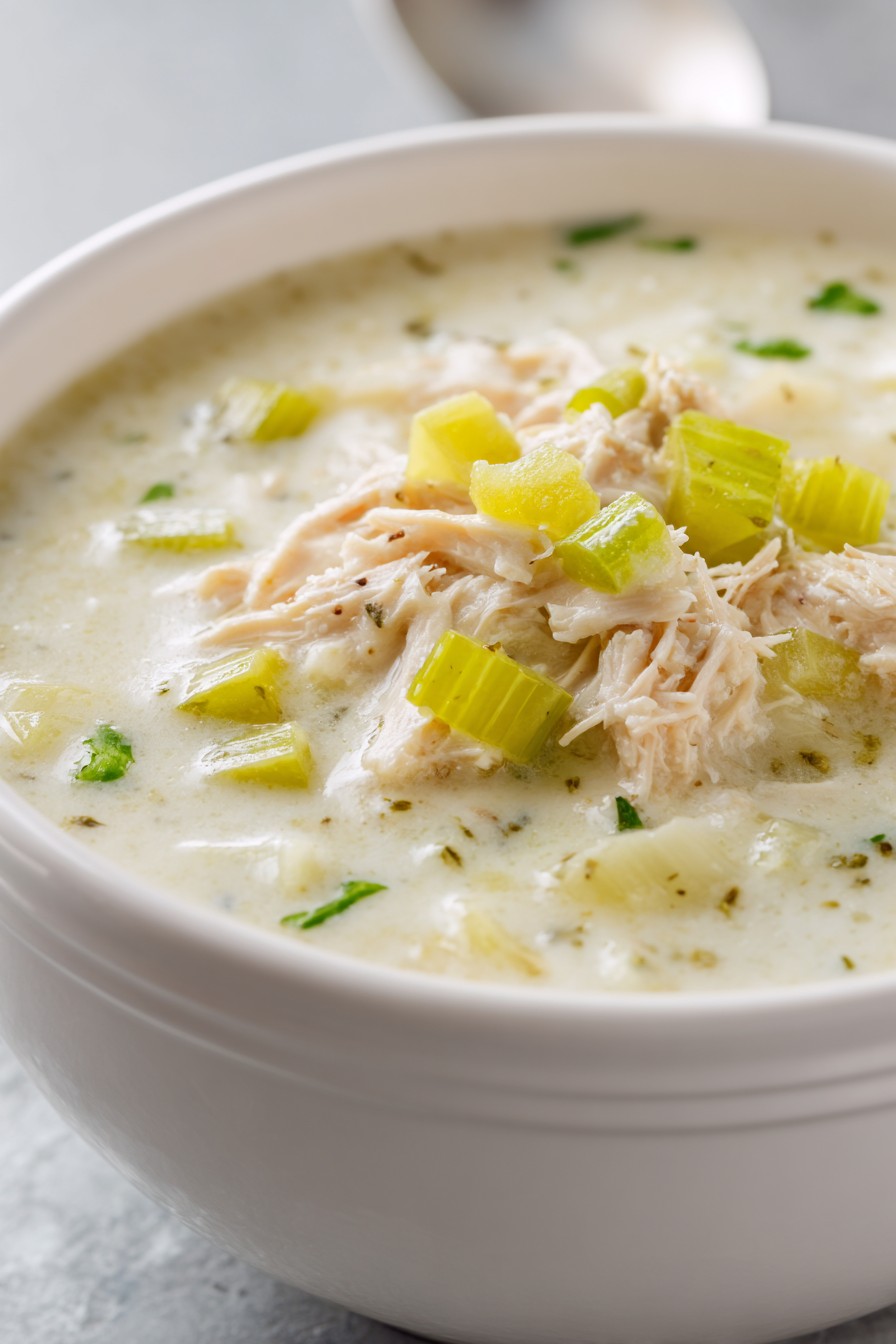Keeping dinner simple doesn’t mean sacrificing flavor. This cream of chicken soup delivers rich, comforting taste with minimal effort. You’ll appreciate how easily it comes together for a satisfying meal.
Why This Recipe Works
- The combination of butter and flour creates a smooth roux that thickens the soup evenly without lumps, ensuring perfect texture in every spoonful
- Using both chicken broth and milk provides balanced flavor while maintaining the creamy consistency that defines this classic soup
- Simmering the soup for exactly 15 minutes allows flavors to meld properly while preventing the dairy from separating or curdling
- Adding cooked chicken at the end preserves its texture and prevents it from becoming tough or stringy during cooking
- The simple seasoning blend of salt, pepper, and garlic powder enhances the chicken flavor without overwhelming the delicate cream base
Ingredients
- 4 tablespoons unsalted butter
- 1/2 cup all-purpose flour
- 1 medium yellow onion, finely diced
- 2 celery stalks, finely chopped
- 4 cups chicken broth
- 2 cups whole milk
- 2 cups cooked chicken, shredded or diced
- 1 teaspoon salt
- 1/2 teaspoon black pepper
- 1/2 teaspoon garlic powder
Equipment Needed
- Large pot or Dutch oven
- Wooden spoon or spatula
- Measuring cups and spoons
- Cutting board
- Chef’s knife
- Ladle
Instructions

Prepare the Vegetable Base
Melt the 4 tablespoons of unsalted butter in a large pot over medium heat. Once the butter has completely melted and begins to bubble slightly, add the finely diced yellow onion and chopped celery stalks. Cook these vegetables for 6-8 minutes, stirring occasionally with a wooden spoon. You’ll know they’re ready when the onions become translucent and the celery softens slightly. The vegetables should release their natural juices and become fragrant but not brown. This initial cooking step develops the foundational flavors that will carry through the entire soup. Properly softened vegetables ensure they blend seamlessly into the final texture rather than remaining crunchy or distinct. Take care not to rush this step, as undercooked vegetables can affect the overall mouthfeel of the finished soup.
Create the Roux
Sprinkle the 1/2 cup of all-purpose flour evenly over the cooked vegetables and butter in the pot. Use your wooden spoon to stir continuously for 2 minutes, ensuring the flour completely incorporates with the butter and coats all the vegetable pieces. The mixture will form a thick paste that should bubble gently but not brown. This cooking time allows the raw flour taste to dissipate while creating the thickening power needed for your soup. A properly made roux should have a pale golden color and smooth, paste-like consistency. If the roux appears too dry, you can add another tablespoon of butter. If it seems too wet, sprinkle in an additional tablespoon of flour. The key is constant stirring to prevent burning and ensure even cooking.
Add Liquids Gradually
Begin by pouring 1 cup of the 4 cups chicken broth into the roux mixture, stirring vigorously with your wooden spoon to incorporate. The mixture will thicken dramatically initially, which is normal. Continue adding the remaining chicken broth in 1-cup increments, stirring thoroughly after each addition until the mixture becomes smooth. Once all chicken broth is incorporated, slowly pour in the 2 cups of whole milk while continuing to stir. The gradual addition prevents lumps from forming and ensures a velvety texture. Bring the mixture to a gentle simmer over medium heat, which should take approximately 5-7 minutes. You’ll notice the soup beginning to thicken slightly as it heats. Avoid boiling at this stage to prevent the dairy from separating.
Season and Simmer
Add the 1 teaspoon salt, 1/2 teaspoon black pepper, and 1/2 teaspoon garlic powder to the simmering soup. Stir to distribute the seasonings evenly throughout the liquid. Reduce the heat to low and cover the pot with a lid. Allow the soup to simmer gently for exactly 15 minutes, stirring occasionally to prevent sticking on the bottom. During this time, the flavors will meld together and the soup will reach its final thickened consistency. The surface should show occasional small bubbles but not vigorous boiling. Tip: For best flavor development, avoid removing the lid frequently during this simmering period as it allows heat and steam to escape, extending the cooking time needed for proper flavor integration.
Incorporate Chicken and Final Adjustments
After the 15-minute simmer, turn off the heat and add the 2 cups of cooked chicken to the soup. Stir gently to distribute the chicken throughout the liquid. Let the soup stand for 5 minutes off the heat to allow the chicken to warm through and absorb some of the broth. This resting period also allows the final flavors to settle. Taste the soup and adjust seasoning if needed—you may want to add more salt or pepper according to your preference. Tip: If the soup has thickened more than desired, you can thin it with additional chicken broth or milk, 1/4 cup at a time, until reaching your preferred consistency. Serve immediately while hot.
Tips and Tricks
For the smoothest possible soup texture, consider using an immersion blender briefly on the vegetable base after adding the first cup of chicken broth. This technique creates a more uniform consistency while maintaining the roux’s thickening power. If you don’t have an immersion blender, you can carefully transfer about half of the soup to a standard blender, blend until smooth, then return it to the pot. Always exercise caution when blending hot liquids—never fill the blender more than halfway and hold the lid firmly in place with a towel.
When selecting chicken for this recipe, roasted chicken provides the deepest flavor, while poached or boiled chicken offers a cleaner taste. You can use leftover chicken from another meal or cook chicken specifically for this soup. To cook chicken specifically for this recipe, place 1 pound of boneless, skinless chicken breasts or thighs in a saucepan, cover with water or chicken broth, and simmer for 15-20 minutes until cooked through. Let cool before shredding or dicing. The cooking liquid can be used as part of the 4 cups chicken broth required in the recipe.
For make-ahead convenience, this soup stores exceptionally well. Cool completely before transferring to airtight containers and refrigerate for up to 4 days. When reheating, do so gently over medium-low heat, stirring frequently. The soup may thicken upon refrigeration—thin with additional broth or milk when reheating. This soup also freezes well for up to 3 months. Freeze in portion-sized containers for easy meals. Thaw overnight in the refrigerator before reheating. Stir well after reheating as separation may occur during freezing.
If you need to modify the recipe for dietary needs, several substitutions work well. For gluten-free version, replace the all-purpose flour with an equal amount of cornstarch or gluten-free flour blend. Mix cornstarch with cold water before adding to create a slurry. For dairy-free, use olive oil instead of butter and unsweetened almond or coconut milk instead of whole milk. The flavor profile will be different but still delicious. For lower fat version, use 2 tablespoons butter and 2 tablespoons olive oil, and replace whole milk with 2% or skim milk.
Recipe Variations
- Add 1 cup of frozen mixed vegetables during the final 10 minutes of cooking for a heartier vegetable chicken soup. Corn, peas, carrots, and green beans work particularly well. The additional vegetables increase the nutritional content and add color and texture variety. Adjust cooking time slightly to ensure the vegetables become tender but not mushy. You may need to add extra broth or milk to maintain the desired soup consistency with the added vegetables.
- Incorporate 1/2 cup of wild rice during the liquid addition step for a creamy chicken and wild rice soup variation. Wild rice adds nutty flavor and chewy texture that complements the creamy base. Use 1 cup additional chicken broth to account for the rice absorption during cooking. Simmer for 30-40 minutes until rice is tender, then proceed with the remaining steps. The extended cooking time allows the rice to fully cook and release its starch, which further thickens the soup naturally.
- Transform the soup into a mushroom chicken version by adding 8 ounces of sliced cremini mushrooms when cooking the onions and celery. Sauté until the mushrooms release their liquid and become golden brown. The earthy mushroom flavor pairs beautifully with the creamy chicken base. For enhanced mushroom flavor, use 1 cup of mushroom broth substituted for 1 cup of the chicken broth. The dual mushroom preparation methods create layers of mushroom flavor throughout the soup.
- Create a herb-infused version by adding 1 tablespoon of fresh thyme leaves or 2 teaspoons of dried thyme along with the seasonings. Other herb options include rosemary, sage, or tarragon, though use these more sparingly as they have stronger flavors. Fresh parsley added at the end provides brightness and color. For Italian-inspired variation, add 1 teaspoon of dried oregano and 1/2 teaspoon of red pepper flakes with the seasonings, and garnish with grated Parmesan cheese before serving.
Frequently Asked Questions
Can I use raw chicken instead of cooked chicken in this recipe?
Yes, you can use raw chicken, but the cooking method changes significantly. Add 1 pound of raw, diced chicken breast or thighs after creating the roux and before adding the liquids. Cook the raw chicken for 5-7 minutes until no longer pink, then proceed with adding liquids as directed. The total simmering time should increase to 20-25 minutes to ensure the chicken cooks thoroughly. Using raw chicken allows the meat to absorb more flavor from the soup base, but may result in slightly less tender chicken compared to adding pre-cooked chicken at the end.
How can I prevent my cream soup from curdling?
Preventing curdling requires careful temperature control and proper technique. Always add dairy to a warm but not boiling base, and avoid boiling the soup after adding milk. The roux helps stabilize the dairy by coating fat molecules. Using whole milk rather than lower fat options provides more stability due to higher fat content. If concerned about curdling, you can temper the milk by gradually adding a small amount of hot soup to the milk before incorporating it into the main pot. Acidic ingredients can increase curdling risk, so avoid adding lemon juice or vinegar unless specifically called for in variations.
What’s the difference between this homemade version and canned cream of chicken soup?
Homemade cream of chicken soup offers significant advantages over canned versions. You control all ingredients, avoiding preservatives, excess sodium, and artificial flavors common in canned soups. The texture is noticeably creamier and more velvety, without the sometimes-gelatinous consistency of canned products. Flavor is richer and more authentic, with pronounced chicken essence rather than generic “cream soup” taste. Homemade version allows customization of thickness, salt level, and additional ingredients. While canned soup works for quick cooking applications, homemade provides superior eating experience as a standalone soup.
Can I make this soup in a slow cooker?
Yes, with modifications. Prepare the roux on the stovetop first by melting butter, cooking vegetables, and incorporating flour. Transfer this mixture to the slow cooker. Add chicken broth, seasonings, and raw chicken if using. Cook on low for 6-7 hours or high for 3-4 hours. Remove chicken, shred or dice, then return to slow cooker. Stir in milk during the last 30 minutes of cooking. Slow cooker method develops deeper flavors but may result in slightly thinner consistency. If thicker soup is desired, create a cornstarch slurry (2 tablespoons cornstarch mixed with 1/4 cup cold water) and stir in during last 15 minutes.
How can I make this soup thicker or thinner?
Adjusting thickness is straightforward. For thicker soup, create additional roux by melting 1 tablespoon butter with 2 tablespoons flour in a separate pan, cooking for 2 minutes, then whisking into the simmering soup. Alternatively, mix 2 tablespoons cornstarch with 1/4 cup cold water until smooth, then stir into the soup and simmer for 5 minutes until thickened. For thinner soup, add additional chicken broth or milk in 1/4 cup increments until desired consistency is reached. Remember the soup will thicken slightly as it cools, so aim for slightly thinner than perfect when hot. Always adjust seasoning after modifying thickness.
Summary
This cream of chicken soup combines simple techniques with quality ingredients for comforting results. The method ensures smooth texture and balanced flavors every time. Customize with variations or follow the classic approach for reliable satisfaction.
Cream of Chicken Soup
4
servings15
minutes30
minutesIngredients
Instructions
- 1 Melt butter in large pot over medium heat. Add onion and celery, cook 6-8 minutes until softened.
- 2 Sprinkle flour over vegetables, stir 2 minutes to form roux.
- 3 Gradually add chicken broth, then milk, stirring constantly until smooth.
- 4 Add seasonings, simmer covered 15 minutes on low heat.
- 5 Stir in cooked chicken, let stand 5 minutes before serving.



